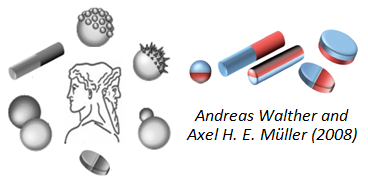
A Janus particle is composed of two fused parts, two-faced, like the Roman god Janus of doorways who is usually depicted with his faces looking in opposite directions. These asymmetric particles have two distinctly different sides, i.e. each face made from a different surface chemistry, or substance, than the other one. This kind of particles is fundamental elements in nature and technology and there is a high recognition that these anisotropic particles have promising applications into different fields. Janus particles may be useful for directed drug delivery carrying simultaneously two different and complementary medicines. For instance, one side of the particle could have specific properties in order to bind to diseased cells (tumor cell), while the opposite side would carry the suitable drug for the treatment of these cells, thus providing a novel anti-cancer therapy. In addition, there is a wide range of Janus particles applications, such as in the design of novel microrheometers, microscopic mixers, self-propelling microsensors, electronic display devices, and even in the improved performance of the solar panels.
For years, worldwide researchers have been fascinated by the innumerable and wonderful applications of these miniscule particles. However, despite enormous progress in the design and synthesis of these anisotropic particles, fundamental studies in this area have been limited thus becoming one of the big challenges to overcome by the scientists.
